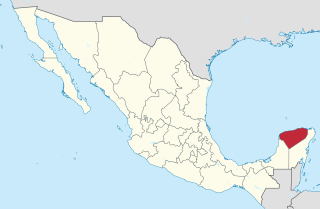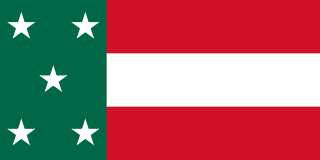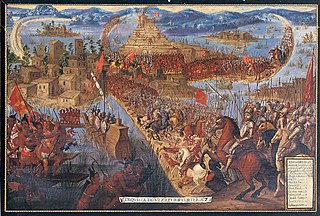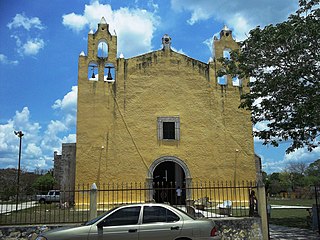Related Research Articles

Yucatán, officially the Free and Sovereign State of Yucatán, is one of the 32 states which comprise the Federal Entities of Mexico. It is divided into 106 municipalities, and its capital city is Mérida.

Oxkutzcab Municipality is a municipality, with a municipal seat of the same name in the Mexican state of Yucatán, southeast of Maní, Yucatán, located at 20°18′10″N89°25′0″W. The name in the Yucatec Maya language means "Place of ramon, tobacco, and honey".

Chan Santa Cruz was the name of a shrine in Mexico of the Maya Cruzob religious movement. It was also the name of the town that developed around it and, less formally, the late 19th-century indigenous Maya state, in what is now the Mexican state of Quintana Roo, of which it was the main center. This area was the center of the Caste War of Yucatán beginning in 1847, by which the Maya established some autonomous areas on the east side of the Yucatán Peninsula. The main conflict ended in 1915, when they agreed to recognize the Mexican government, but the last time Mexican troops took action against a Maya village in this area was 1933.

The Caste War of Yucatán (1847–1901) began with the revolt of native Maya people of the Yucatán Peninsula against the European-descended population, called Yucatecos. The latter had long held political and economic control of the region. A lengthy war ensued between the Yucateco forces in the northwest of the Yucatán and the independent Maya in the southeast. There was regular raiding between them.

Miguel Barbachano y Tarrazo was a liberal Yucatecan politician, who was 5 times governor of Yucatán between 1841 and 1853.

José Rafael Carrera Turcios was the president of Guatemala from 1844 to 1848 and from 1851 until his death in 1865, after being appointed President for Life in 1854. During his military career and presidency, new nations in Central America were facing numerous problems: William Walker's invasions, liberal attempts to overthrow the Catholic Church and aristocrats' power, the Civil War in the United States, Mayan uprising in the east, Belize boundary dispute with England, and the wars in Mexico under Benito Juarez. This led to a rise of caudillos, a term that refers to charismatic populist leaders among the indigenous people. Many regional and national caudillos were interested in power for their own gain. Carrera was an exception as he genuinely took the interests of Guatemala's Indian majority to heart.

Justo Sierra O'Reilly was a Mexican novelist and historian, the father of Mexican author and political figure Justo Sierra Méndez. Sierra O'Reilly was born in the southeastern Mexican state of Yucatán, his father-in-law Santiago Méndez Ibarra was the governor there in 1847, in the middle of the Mexican–American War and at the outbreak of the Caste War of Yucatán. In September of that year, he went to the United States as a negotiator on behalf of his father-in-law's government, to request U.S. military aid against the Maya rebels, and to offer the possibility of U.S. annexation of Yucatán in exchange. His attempts at diplomacy on behalf of the quasi-independent peninsula went nowhere, and by the time he returned home in 1848, Mexico had lost the northern half of its territory to the U.S. but had also solved its differences with Yucatán, and Sierra O'Reilly found himself with an unemployed father-in-law and no government position for himself. It was then, at the age of 34, that he turned to literature. The chapters of his popular melodramatic novel, La Hija del Judío, a historical novel in the style of Sir Walter Scott about the star-crossed love of the daughter of a Jewish merchant in colonial Mexico, were published in installments in El Fénix, a newspaper that he founded in Campeche. Published years later in book form, the novel sold well all over Latin America. His other works include the pirate novel El Filibustero, the travel journal Impresiones de un viaje a los Estados Unidos de América y al Canadá (1851), and numerous writings on the regional history of Yucatán such as Teogonía de los antiguos indios and Importancia de un Museo de Antigüedades, as well as Spanish translations of John Lloyd Stephens's works on Yucatán.

San Joaquin is a village in the Corozal District of Belize. With a population of about 2000 people, it is one of the largest villages in Corozal. The town was formed as a result of Mestizos migrating to escape the 1847–1901 Caste War of Yucatán.

Maxcanú Municipality is one of the 106 municipalities in the Mexican state of Yucatán. Its seat is the town of Maxcanú. The municipality covers an area of approximately 1,321 km² and is located roughly 52 km southwest of the city of Mérida.

The Republic of Yucatán was a sovereign state during two periods of the nineteenth century. The first Republic of Yucatán, founded May 29, 1823, willingly joined the Mexican federation as the Federated Republic of Yucatán on December 23, 1823, less than seven months later. The second Republic of Yucatán began in 1841, with its declaration of independence from the Centralist Republic of Mexico. It remained independent for seven years, after which it rejoined the United Mexican States. The area of the former republic includes the modern Mexican states of Yucatán, Campeche and Quintana Roo. The Republic of Yucatán usually refers to the Second Republic (1841–1848).
Santa Elena Municipality is one of the 106 municipalities in the Mexican state of Yucatán containing (694.90 km2) of land and is located roughly 95 km south of the city of Mérida.

The Mexican Indian Wars were a series of conflicts fought between Spanish, and later Mexican, Guatemalan, Honduran, Salvadoran and Belizean forces against Amerindians in what is now called Mexico and surrounding areas such as Belize, Guatemala, Honduras, El Salvador and Southern/Western United States. The period begins with Spanish conquest of the Aztec Empire in 1519 and continued until the end of the Caste War of Yucatán in 1933.
Santiago Imán was a Creole revolutionary involved in a series of events that led to, and help cause, the Caste War of Yucatán and was born in 1800. Through 1839 to 1840, starting on May 29, he led a revolt which helped push the Yucatán's separation from Mexico, which was currently going through tough problems after the Pastry War with France and was also having difficulty, and weakness, regaining territory lost to the U.S, including Texas. He encouraged Federalism in the Yucatán once Mexican independence came and Spanish rule was eliminated. He was higher up in the caste like system at the time as a merchant Creole who owned land in the city of Tizimin. The Centralized Mexican government at the time was becoming more frustrated, in need of men to reconquer Texas from the United States, and sought to gather soldiers by being more oppressive to this deed. Imán knew that his best bet was to gather the Mayan peoples that resided in the Yucatán to aide in forming Yucatán as an independent nation. He gained their devotion by promising the abolition of Church taxes, which the Mayan people for obvious religious reasons didn't appreciate, and with his ambition and the motivation on the heads of the Mayan peasantry they momentarily drove Independence for the Yucatán till 1843; later Independence periods where brought in a few following years up until 1848 where they were quenched once and for all. His drive brought many social changes including the disuse of public lands, and new forms of awarding individuals for many forms of service mostly including military work. His actions would later drive and motivate more Creole revolutions notably the Caste War of Yucatán in 1847.
Domingo Barret was governor of Yucatán, Mexico. He was interim governor of Yucatán in 1847 during the beginning of the so-called War of the Castes and the time when turning Mexico war with the United States of America, Yucatán decided to remain neutral in the conflict.
Mexican immigration to Cuba comprises people who emigrated from Mexico to Cuba and their descendants. Cuba is home to the most Mexicans living in the Caribbean. The waves of migration from Mexico to Cuba started from the 1970s, attracted by a mild climate and political stability.

Motul Municipality is one of the 106 municipalities in the Mexican state of Yucatán containing (297.63 km2) of land and located roughly 45 km east of the city of Mérida.

Tixpéhual Municipality is one of the 106 municipalities in the Mexican state of Yucatán containing (68.98 km2) of land and located roughly 25 km east of the city of Mérida.

Suma Municipality is one of the 106 municipalities in the Mexican state of Yucatán containing 39.60 square kilometres (15.29 sq mi) of land and located roughly 55 kilometres (34 mi) northeast of the city of Mérida.

Chichimilá Municipality is one of the 106 municipalities in the Mexican state of Yucatán containing (358.59 km2) of land and located roughly 170 km southeast of the city of Mérida.

Chikindzonot Municipality is one of the 106 municipalities in the Mexican state of Yucatán containing (352.56 km2) of land and located roughly 170 km southeast of the city of Mérida.
References
- Reed, Nelson. (1964) The Caste War of Yucatan Stanford University Press, Palo Alto.
- ↑ "E-leaders". www.museogc.com. Retrieved 2018-02-05.
- ↑ (in Spanish) Raúl Casares G. Cantón, Juan Duch Colell; Michel Antochiw Kolpa; Silvio Zavala et álias, Yucatán en el tiempo, Mérida, 1998. ISBN 970 9071 04 1
| This article related to indigenous Mesoamerican culture is a stub. You can help Wikipedia by expanding it. |
| This biographical article related to the military of Mexico is a stub. You can help Wikipedia by expanding it. |